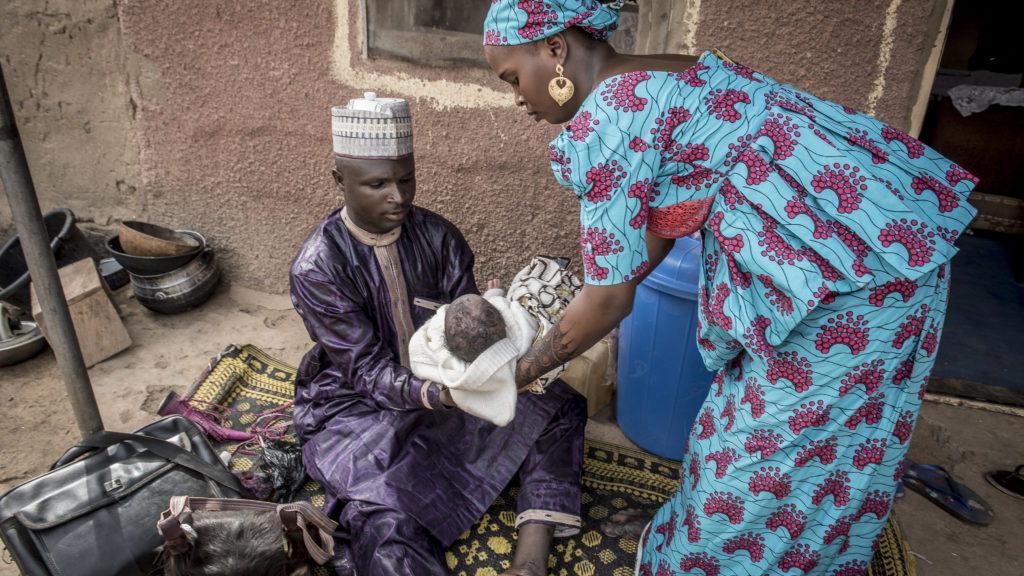This content originally appeared on the STAT website.
It was a typical yet astonishing scene in Wandi village in northeastern Nigeria: a traditional barber known as a wanzam ceremonially shaved Abubakar Nafisatu’s hair on his seventh day of life, as is the custom there. Then the barber did something not so customary: He stressed to Abukabar’s mother the importance of routine immunization.
Simple though it may seem, I see the wanzam’s offer of medical advice as a marvel of innovation. Let me explain: This scene played out in an area where only 13 percent of children are immunized against diseases like polio, tetanus, whooping cough, and diphtheria by their first birthday. Capitalizing on the influence that traditional barbers have with the families they work with makes sense, especially when the local health system is weak and the rumor mill is rife with claims that immunization causes sterility.
The innovation in this case is not a high-tech invention, an attention-grabbing device, or a revolutionary gadget. It began with public health activists asking: How can we transform everyday practices into lifesaving revolutions? How can we disrupt the status quo and generate positive health outcomes faster, better, more affordably and sustainably?
Answers to these questions sometimes take the shape of novel approaches to delivering health information and care — like engaging barbers to trim not only newborn hair but also newborn mortality.
In the developing world, where surgeons don’t have gloves and clinics don’t have reliable electricity or running water, the word “innovation” takes on a different meaning than it does in more developed parts of the world. Here, seeming small changes can lead to policy breakthroughs, new operating systems, revitalized business practices, and revamped models of care that significantly improve health.
Take the example of prenatal care, known more formally among global health experts as antenatal care.
Citing the importance of health screenings and other prevention measures for pregnant women in developing countries, the World Health Organization recently upped its recommendation from four antenatal visits to eight. Given that only two-thirds of women in low- and middle-income countries manage to attend four visits, we need a fast, transformative fix.
Across villages in Africa, moms-to-be often stand in the sun, waiting for hours to see the lone midwife in their community. Meanwhile, their antenatal visits last for mere minutes per woman — averaging 12 minutes for the first visit and 6.5 minutes for subsequent ones. That is hardly enough time to assess a mother and her unborn child and offer everything from lifesaving screenings for conditions like high blood pressure to medicines for malaria and HIV. No wonder women were inclined to postpone their visits until very late in pregnancy, or shrug them off after a disappointing initial visit. The one-on-one service model didn’t work.
As an alternative, one of the partners of the organization I direct, the U.S. Agency for International Development’s Maternal and Child Survival Program, took a concept developed in the U.S. and tested it across several African nations. The idea: invite groups of pregnant women to meetings led by facilitators specially trained to conduct what’s called participatory antenatal care. Instead of only being seen by a health care provider, women work together in groups to take an active role in caring for themselves and their babies.
The women were enthusiastic to learn how to take each other’s blood pressure, as well as to discuss birth plans and breastfeeding. They sang and danced together and, just as important, they returned for subsequent sessions, sometimes inviting their partners.
At an antenatal care group meeting in rural Nigeria, Ruth Anmusku’s husband, Peter, said he appreciated that HIV screening was available for him and his wife. “If a man and a woman get pregnant, then they also get tested together,” he said. “This really attracted me to this group.”
Not only did attendance at the meetings remain high, but group antenatal care resulted in more women choosing to deliver in health facilities where complications like postpartum hemorrhage — the leading cause of maternal death around the world —can be managed with competence. (These results will be presented at the United Nation’s General Assembly now going on in New York.)
This new twist on delivering antenatal care in resource-poor settings has become part of the fabric of family and community life in places where it never was before. That’s innovating for impact.
Adapt, scale up, sustain
Innovation is also about taking proven, everyday health care strategies — such as use of chlorhexidine, an antibiotic — and applying it in new and different contexts. In Nigeria, depending on cultural practice or tradition, newborns’ umbilical cord stumps are coated with everything from engine oil to toothpaste or cow dung. To prevent umbilical cord infections, which unnecessarily kill thousands of babies a year, the country has an ambitious plan for safe, cheap, and easy-to-apply chlorhexidine. Using the antibiotic on 52 percent of Nigerian newborns by 2021 could avert an estimated 55,000 newborn deaths over five years.
Yet even a seemingly simple intervention like this means looking through an innovative lens at all the steps of the process, from establishing a reliable supply chain to generating demand among wary parents whose own umbilical cord stumps may have been coated with something less hygienic.
The path is not always clear. It’s often essential to step back before moving forward. Refocusing an initial definition of success can help innovators further adapt their ideas for different environments.
Reaching goals faster, more effectively, and affordably
Innovation happens when unlike minds come together to design creative solutions to global development challenges. One of the overarching, ongoing challenges for many of us working in places like Bangladesh, Rwanda, and Myanmar is ensuring that frontline health workers have the skills, competence, and confidence they need. It serves us well to be open to adopting innovations into practice no matter how disruptive they may be — like reinventing the way that nurses and midwives get extra training.
Traditional in-service maternity training for nurses and midwives means they must travel far from their communities to big-city hotel conference rooms where they spend a day or two watching experts demonstrate the skills to successfully manage complicated births. Then they go back to their local health centers which, during their absence, were short staffed. While nurses and midwives might appreciate a brief respite from their day-to-day work, these offsite brain dumps don’t necessarily improve patient outcomes.
Enter the innovators, who shortened the trainings and conducted them on the job in concentrated bursts. They then followed up with lots of hands-on practice and mentoring.
When midwives in Ghana and Uganda were trained that way, the results were stunning. These clinicians retained more knowledge and skills, fewer newborns died from asphyxia, and more moms survived postpartum hemorrhage. Not inconsequently, the new training also represented a cost savings.
Sustaining the bright idea
One of the hard parts of innovation is the sustained effort that’s needed to refine and adapt solutions for new communities. The Maternal and Child Survival Program aims for large-scale impact, which means learning from missteps and failures.
Many reproductive health programs that target adolescents focus on delaying marriage or the first pregnancy. But that overlooks teens who have already started their reproductive lives. A young mother’s risk of death and disability rises quickly as she continues to have more children.
Focusing on and investing in the health of new moms like Constantine Atta — who had her first child at 19 — represents an innovative approach. Like many of her peers in central Ghana, Constantine didn’t plan to have her first baby as early as she did, and didn’t want a second child right away. But that decision wasn’t hers alone. She needed to convince her boyfriend, Eric, and his well-meaning but misinformed mother who is supporting the couple, that contraception wouldn’t make Constantine promiscuous, sick, or sterile.

Fortunately for Constantine, Gloria, a specially-trained and doggedly persistent community health worker, had her back. Gloria visited twice monthly to tend to the needs of the new mother and her baby. During these visits, she impressed upon Constantine, Eric, and his mother the benefits of healthy birth spacing. She encouraged the couple to attend a support group for first-time parents. Over time, they, along with Eric’s mother, jointly decided that a long-acting contraceptive would safeguard the health of mom, baby, and family.
It’s only right for Constantine to have the last word. Not because of what innovation has done for her, but because of how she inspires me to keep innovating. She’s proof positive that rethinking beliefs, reinventing visions, and reimagining new and better ways to save lives require no bells or whistles — just a hefty measure of grit and fortitude.
As a poor, unmarried pregnant teen, Constantine might have given up on her dreams. But instead she offers this: “We can give birth, adopt a family-planning method to space childbirth, and learn a trade to better our lives.”

